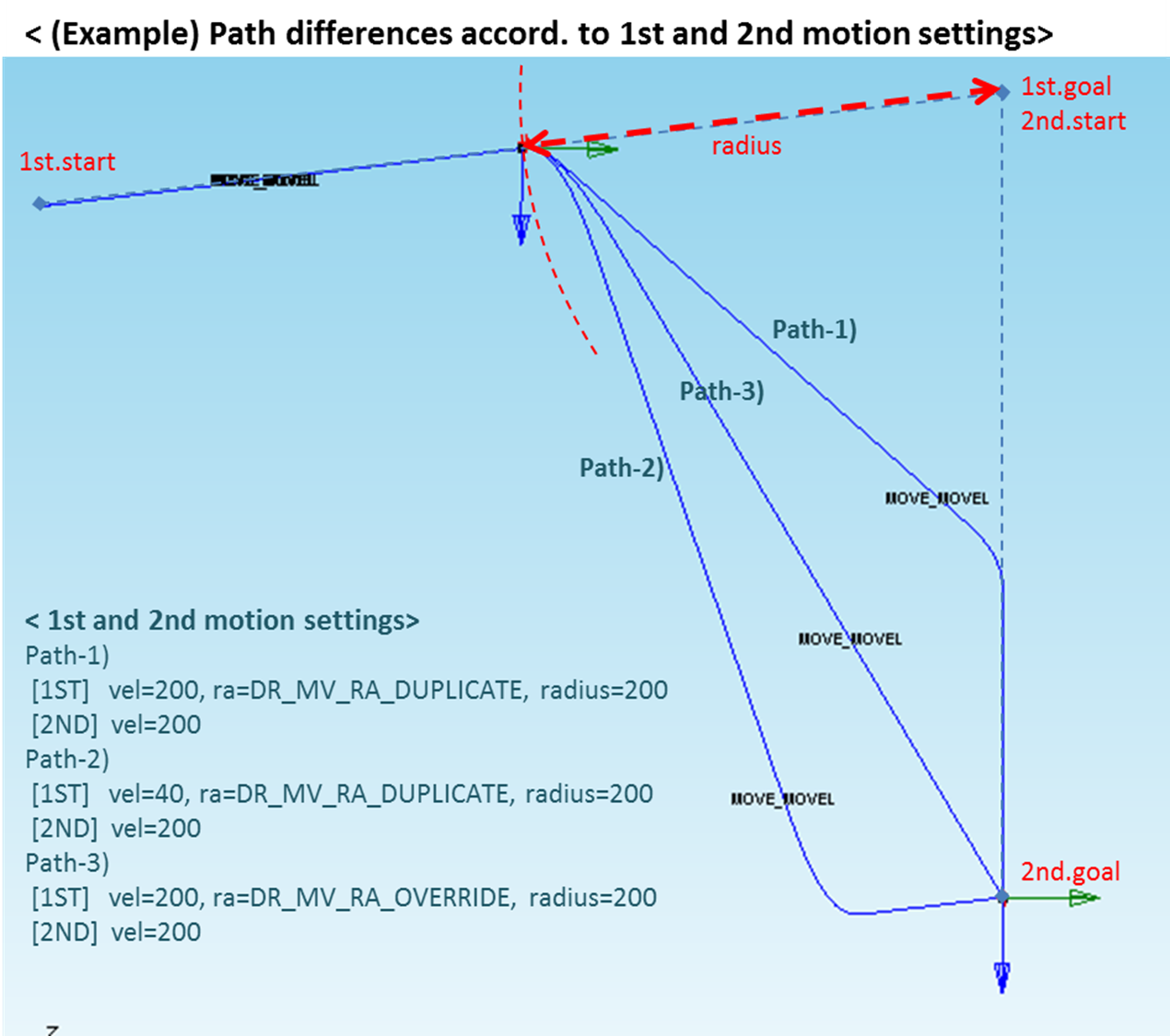CDRFLEx.movec
Features
This is a function for moving the robot along an arc to the target position via a waypoint or to a specified angle from the current position based on the task space in the task space.
Parameter
Parameter Name | Data Type | Default Value | Description |
fTargetPos[0] | float[6] | - | Waypoint |
fTargetPos[1] | float[6] | Target location | |
fTargetVel | float[2] | - | Linear Velocity, Angular Velocity |
fTargetAcc | float[2] | - | Linear Acceleration, Angular Acceleration |
fTargetTime | float | 0.0 | Reach Time [sec] |
eMoveMode | enum.MOVE_MODE | MOVE_MODE_ ABSOLUTE | Refer to the Definition of Constant and Enumeration Type |
eMoveReference | enum.MOVE_REFERENCE | MOVE_REFERENCE_BASE | Refer to the Definition of Constant and Enumeration Type |
fTargetAngle1 | float | 0.0 | angle1 |
fTargetAngle2 | float | 0.0 | angle2 |
fBlendingRadius | float | 0.0 | Radius for blending |
eBlendingType | enum.BLENDING_SPEED_TYPE | BLENDING_SPEED_TYPE_DUPLICATE | Refer to the Definition of Constant and Enumeration Type |
Note
- If an argument is inputted to fTargetVel (e.g., fTargetVel ={30, 0}), the input argument corresponds to the linear velocity of the motion, while the angular velocity is determined proportionally to the linear velocity.
- If an argument is inputted to fTargetAcc (e.g., fTargetAcc ={60, 0}), the input argument corresponds to the linear acceleration of the motion, while the angular acceleration is determined proportionally to the linear acceleration.
- If fTargetTime is specified, values are processed based on fTargetTime, ignoring fTargetVel and fTargetAcc .
- If the eMoveMode is MOVE_MODE_RELATIVE, fTargetPos[0] and fTargetPos[1] are defined in the relative coordinate system of the previous position. (fTargetPos[0] is the relative coordinate from the starting point, while fTargetPos[1] is the relative coordinate from fTargetPos[0].)
- If fTargetAngle1 is more than 0, and fTargetAngle2 is equal to 0, the total rotated angle on the circular path is applied to fTargetAngle1.
- When fTargetAngle1 and fTargetAngle2 are more than 2, fTargetAngle1 refers to the total rotating angle moving at a constant velocity on the circular path, while fTargetAngle2 refers to the rotating angle in the rotating section for acceleration and deceleration. In that case, the total moving angle fTargetAngle1+ 2 X fTargetAngle2 moves along the circular path.
Caution
If the following motion is blended with the conditions of eBlendingType being BLENDING_SPEED_TYPE_DUPLICATE and fBlendingRadius>0, the preceding motion can be terminated after the following motion is terminated first when the remaining motion time, which is determined by the remaining distance, velocity, and acceleration of the preceding motion, is greater than the motion time of the following motion. Refer to the following image for more information.

Return
Value | Description |
0 | Error |
1 | Success |
Example
// CASE 1
float x1[2][6] = {{559,434.5,651.5,0,180,0}, {559,434.5,251.5,0,180,0}};
float tvel = {50,50}; # Set the task velocity to 50(mm/sec) and 50(deg/sec).
float tacc = {100,100}; # Set the task acceleration to 100(mm/sec2) and 100(deg/sec2).
drfl.movec(x1, tvel, tacc);
// Moves to x1[1] with a velocity of 50(mm/sec) and acceleration of 100(mm/sec2)
// via x1[0] along the arc trajectory.
// CASE 2
float x1[2][6] = {{559,434.5,651.5,0,180,0},{559,434.5,251.5,0,180,0}};
float tTime = 5;
drfl.movec(x1, 0, 0, tTime);
// Moves along the arc trajectory to x1[1] via x1[0] with a reach time of 5 seconds
// CASE 3
float x1[2][6] = {{559,434.5,651.5,0,180,0},{559,434.5,251.5,0,180,0}};
float x2[2][6] = {{559,234.5,251.5,0,180,0 },{559,234.5,451.5,0,180,0}};
float tvel = {50,50};
float tacc = {100,100};
float blending_radius = 50;
drfl.movec(x1, tvel, tacc, 0, MOVE_MODE_ABSOLUTE, MOVE_REFERENCE_BASE, 0, 0, blending_radius);
drfl.movec(x2, tvel, tacc, 0, MOVE_MODE_ABSOLUTE, MOVE_REFERENCE_BASE, 0, 0, 0, BLENDING_SPEED_TYPE_DUPLICATE);
